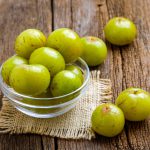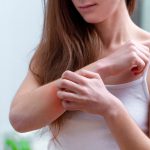Ashwagandha in Sanskrit means “smell of the horse” to correlate it with the strength of…
Read MoreAre you troubled by pimples? You’re not alone! It is estimated that around 95% of people suffer from acne between eleven and thirty years of age.[1][Overview Acne]( Acne – NHS (www.nhs.uk)”Overview Acne”). NHS.UK. While it’s most common among teenagers and young adults, some people suffer from this problem even in their 40s and 50s.
Manjistha herb (Rubia cordifolia) or Indian madder is a perennial climber with reddish bark. It has been utilized in Ayurveda to treat various conditions like herpes, haemorrhoids, snake bites, eye diseases, menstrual disorders, etc.
There are multiple manjistha benefits for skin and blood disorders. Its varnya (complexion improving), raktashodhak (blood purifying), vishaghna (toxin removing), rasayana (rejuvenating), and krimighna (anthelmintic – that destroys worms) properties are thought to make it ideal for tackling acne.
Acne develops when tiny pores in our skin, known as hair follicles, get clogged. Hair grows out of these pores, and they are attached to glands that secrete oil or sebum, which prevents our skin and hair from becoming dry. If these glands produce excess oil, they can mix with dead skin cells and block hair follicles, leading to whiteheads and blackheads. Bacteria that live on your skin and are typically harmless can infect these blocked follicles and cause inflammation leading to pustules, cysts, nodules, or papules.
Ayurveda describes this condition as yauvanapidika. It is considered to develop due to an imbalance in kapha (related to the elements of water and earth), vata (related to the elements of air and ether), and rakta (blood which is related mainly to the fire element) in the body.[2]Pampaniya, Piyush V., and Darshana H. Pandya. “Effect of Shalmalyadilepa and Guduchyadivati in the management of Yauvanapidika (Acne).” Ayu 34, no. 2 (2013): 174.[3]Shilpa, S., and CG Venkatesha Murthy. “Understanding personality from Ayurvedic perspective for psychological assessment: A case.” Ayu 32, no. 1 (2011): 12.
Depending on how severe your condition is, you might get:
Essentially, the four major factors that cause acne are:
However, other factors can increase your chances of suffering from this condition:
Hormones can have an impact on whether you get acne. Teenage acne is triggered by testosterone, which increases during puberty. Testosterone is thought to trigger your sebaceous glands to overproduce sebum.
Hormonal changes due to pregnancy or periods can also lead to acne. Even hormonal disorders such as polycystic ovary syndrome can lead to an outbreak.
Some medicines, such as lithium and steroids, can trigger acne. Certain medications used for dealing with epilepsy can do so too. Your doctor will be able to inform you if any medication that you’re on can trigger acne.
According to experts, genetics has a part to play in the development of acne. It has been found that you are more likely to get acne if your parents had it. You’re also more likely to get adult acne if both or either of your parents had adult acne.
Do bear in mind that pollution, humidity, stress, and pressure from tight clothes, helmets, or backpacks can aggravate acne. As can roughly scrubbing your skin or picking at your pimples.[4][Acne Causes](https://www.nhs.uk/conditions/acne/causes/ “Acne Causes”). NHS,UK. [5][What causes acne?](What is Acne? Definition & Types | NIAMS (nih.gov) “What causes acne?”). National Institutes of Health. [6][Acne](Acne – Symptoms and causes – Mayo Clinic“Acne”). Mayo Clinic.
Acne is a very common condition that most of us have experienced at some point or the other. However, many misunderstandings regarding it continue to persist. Let’s take a look at some of them:
Research indicates that manjistha herb can inhibit Propionibacterium acnes, a bacterium that plays a crucial role in the pathogenesis of acne. This bacterium functions as a trigger for oxidative stress that leads to acne inflammation. So the antibacterial properties of manjistha for acne might help you get rid of those unsightly zits![9]Gorle, Archana M., and Swati S. Patil. “Evaluation of antioxidant and antiacne property of Rubia cordifolia.” Der Pharmacia Sinica 1, no. 3 (2010): 59-63.
Manjistha herb is also known for its potent anti-inflammatory properties. It has been found to affect two significant inflammatory mediators in the pathogenesis of acne. It suppresses the free radicals induced by Propionibacterium acnes, leading to inflammation. But that’s not all. It has also been found to suppress pro-inflammatory cytokines, which are proteins that play an essential role in the immune system.[10]Jain, A., and E. Basal. “Inhibition of Propionibacterium acnes-induced mediators of inflammation by Indian herbs.” Phytomedicine 10, no. 1 (2003): 34-38.
Acne can leave you with dark spots and scars. This is due to the irregular dispersion or overproduction of melanin, the pigment responsible for skin color. The more melanin you have, the darker your skin is. Skin inflammation due to acne can cause hyperpigmentation.[11]Davis, Erica C., and Valerie D. Callender. “Postinflammatory hyperpigmentation: a review of the epidemiology, clinical features, and treatment options in skin of color.” The Journal of … Continue reading But manjistha herb might help fade those dark spots. After all, it’s famous in Ayurveda for its “varṇya” property. That is, it improves the complexion and gives you an even tone. Research has shown that manjistha benefits for skin include lightening skin tone. This is because it inhibits an enzyme called tyrosinase which plays an important role in the production of melanin.[12]Sharma, Khemchand, Namrata Joshi, and Chinky Goyal. “Critical review of Ayurvedic Varṇya herbs and their tyrosinase inhibition effect.” Ancient Science of life 35, no. 1 (2015): 18.
Here are a couple of ways how to use manjitha for acne:
Dry root and stem powder of manjistha herb is traditionally mixed with honey and applied to the face to erase dark spots and give the complexion an even tone. [13]Sharma, Laxmikant, Gaurav Agarwal, and Ashwani Kumar. “Medicinal plants for skin and hair care.” (2003).
Try this treatment two to three times a week to get rid of acne.
Did you know that like manjistha for acne, honey too has the ability to fight acne-causing bacteria and ease hyperpigmentation?[14]Julianti, Elin, Kasturi K. Rajah, and Irda Fidrianny. “Antibacterial activity of ethanolic extract of cinnamon bark, honey, and their combination effects against acne-causing bacteria.” … Continue reading [15]Jantakee, Kanyaluck, and Yingmanee Tragoolpua. “Activities of different types of Thai honey on pathogenic bacteria causing skin diseases, tyrosinase enzyme and generating free radicals.” … Continue reading That makes this combination a double whammy as far as acne is concerned.
Another way how to use manjistha for acne is by mixing manjistha powder with ghee and used topically to tackle acne.[16]Meena, Vandana. “Manjistha (Rubia cordifolia)-A helping herb in cure of acne.” Journal of Ayurveda and Holistic Medicine (JAHM) 3, no. 2 (2015): 11-17. This is especially beneficial for those with dry skin.
Manjistha is usually safe to use topically. Know how to use manjistha for acne in the right way.
Manjistha commands a lot of respect in Ayurveda for its incredible blood-purifying properties. It has immense regenerative properties and essential bioactive ingredients that effectively heal various skin conditions like acne. It helps improve the functions of the lymphatic system, fight flu symptoms like sore throat, cough, cold and fever, strengthen the liver health, and much more.
Try Kapiva’s Skin Radiance Fizz – a drinkable skincare beverage full of micronutrients and potent Ayurvedic Herbs for your best skin health. Rejuvenate, hydrate and enhance your skin health with the power of 3 Ayurvedic herbs namely Aloe Vera, Manjistha, and Milk Thistle along with 30% RDA of Vitamins A, C, E and more.
FAQs
No. Acne is a disease affecting the skin’s hair follicles, and oil glands and pimples are one of the symptoms of this disease.
Essentially, the four major factors that cause acne are:
You can apply manjistha with ghee or manjistha with honey to heal the pimples. You can also use other herbs like aloe vera, neem, calendula, chamomile, etc. Follow a healthy skincare routine like cleaning your face with mild soap and applying natural moisturizers. You can also try Kapiva’s Skin Radiance Fizz which contains manjistha and aloe with other skin healing herbs.
Yes. Eating foods that contain nutrients that are good for the skin and helps reduce inflammation will help keep acne at bay. Also, avoid foods that aggravate acne like processed foods, sugary items, and dairy products.
References
| ↑1 | [Overview Acne]( Acne – NHS (www.nhs.uk)”Overview Acne”). NHS.UK. |
|---|---|
| ↑2 | Pampaniya, Piyush V., and Darshana H. Pandya. “Effect of Shalmalyadilepa and Guduchyadivati in the management of Yauvanapidika (Acne).” Ayu 34, no. 2 (2013): 174. |
| ↑3 | Shilpa, S., and CG Venkatesha Murthy. “Understanding personality from Ayurvedic perspective for psychological assessment: A case.” Ayu 32, no. 1 (2011): 12. |
| ↑4 | [Acne Causes](https://www.nhs.uk/conditions/acne/causes/ “Acne Causes”). NHS,UK. |
| ↑5 | [What causes acne?](What is Acne? Definition & Types | NIAMS (nih.gov) “What causes acne?”). National Institutes of Health. |
| ↑6 | [Acne](Acne – Symptoms and causes – Mayo Clinic“Acne”). Mayo Clinic. |
| ↑7 | [What Can I Do About Acne?](What Can I Do About Acne? (for Teens) – Nemours Kidshealth“What Can I Do About Acne?”)Nemours Foundation. |
| ↑8 | [Acne Causes](“Acne Causes”). NHS,UK. |
| ↑9 | Gorle, Archana M., and Swati S. Patil. “Evaluation of antioxidant and antiacne property of Rubia cordifolia.” Der Pharmacia Sinica 1, no. 3 (2010): 59-63. |
| ↑10 | Jain, A., and E. Basal. “Inhibition of Propionibacterium acnes-induced mediators of inflammation by Indian herbs.” Phytomedicine 10, no. 1 (2003): 34-38. |
| ↑11 | Davis, Erica C., and Valerie D. Callender. “Postinflammatory hyperpigmentation: a review of the epidemiology, clinical features, and treatment options in skin of color.” The Journal of clinical and aesthetic dermatology 3, no. 7 (2010): 20. |
| ↑12 | Sharma, Khemchand, Namrata Joshi, and Chinky Goyal. “Critical review of Ayurvedic Varṇya herbs and their tyrosinase inhibition effect.” Ancient Science of life 35, no. 1 (2015): 18. |
| ↑13 | Sharma, Laxmikant, Gaurav Agarwal, and Ashwani Kumar. “Medicinal plants for skin and hair care.” (2003). |
| ↑14 | Julianti, Elin, Kasturi K. Rajah, and Irda Fidrianny. “Antibacterial activity of ethanolic extract of cinnamon bark, honey, and their combination effects against acne-causing bacteria.” Scientia pharmaceutica 85, no. 2 (2017): 19. |
| ↑15 | Jantakee, Kanyaluck, and Yingmanee Tragoolpua. “Activities of different types of Thai honey on pathogenic bacteria causing skin diseases, tyrosinase enzyme and generating free radicals.” Biological research 48, no. 1 (2015): 1-11. |
| ↑16 | Meena, Vandana. “Manjistha (Rubia cordifolia)-A helping herb in cure of acne.” Journal of Ayurveda and Holistic Medicine (JAHM) 3, no. 2 (2015): 11-17. |
| ↑17 | Allergy testing – Better Health Channel “Allergy testing”. Better Health Channel. |


Dr. Anand R Dwivedi is an Ayurevedacharya from Mumbai University, 1987. He has been practicing Ayurveda since 1988. He has a special interest in the treatment of chronic illnesses with the help of Ayurveda. He has been associated with Kapiva since 2015 and helping people lead a well-balanced lifestyle through his deep knowledge of Ayurveda.

Ashwagandha in Sanskrit means “smell of the horse” to correlate it with the strength of…
Read More
Pimples - we’ve all had them and we all hate them. And if you’ve ever…
Read More
Don’t all of us want healthy glowing skin? And while there is a ton of…
Read More
Most of us have experienced skin irritations at some point or the other. When the…
Read More